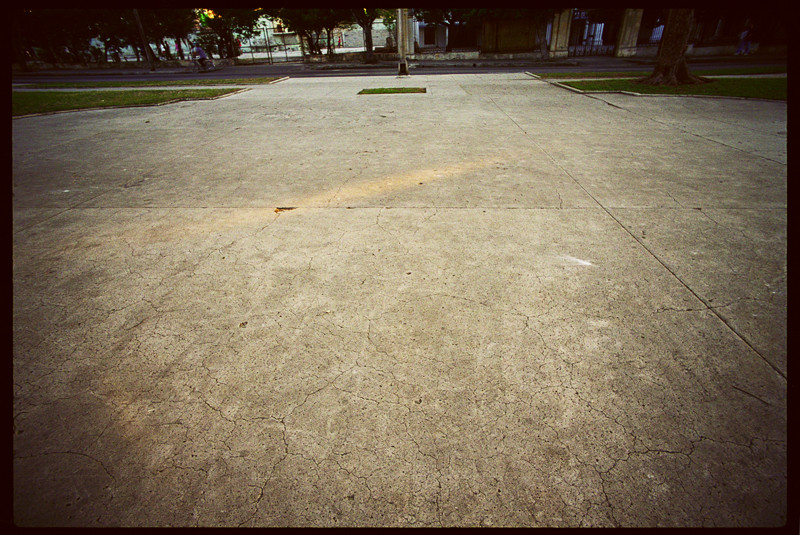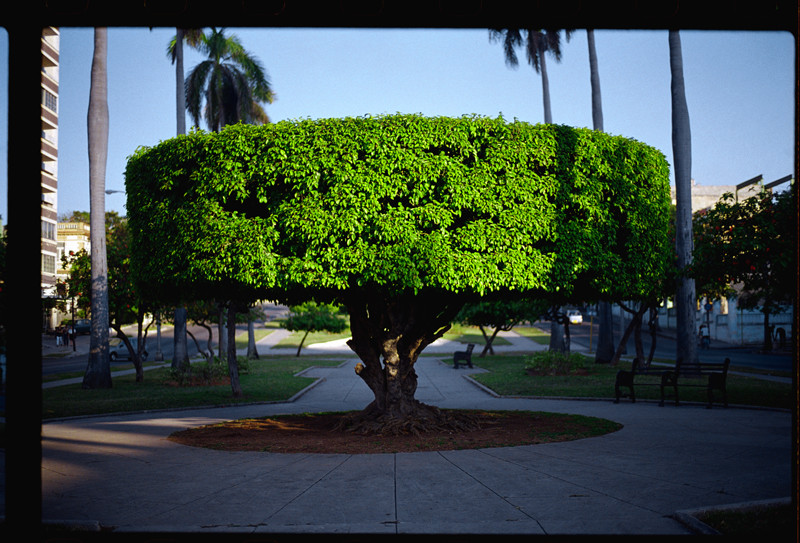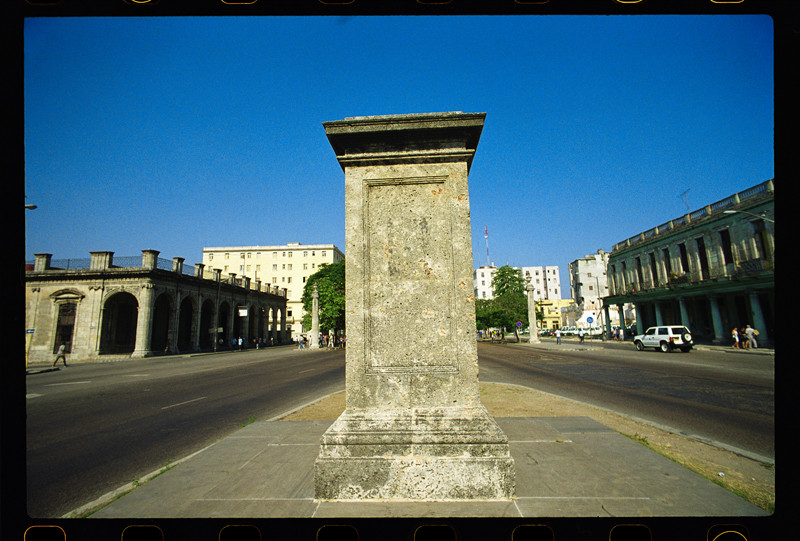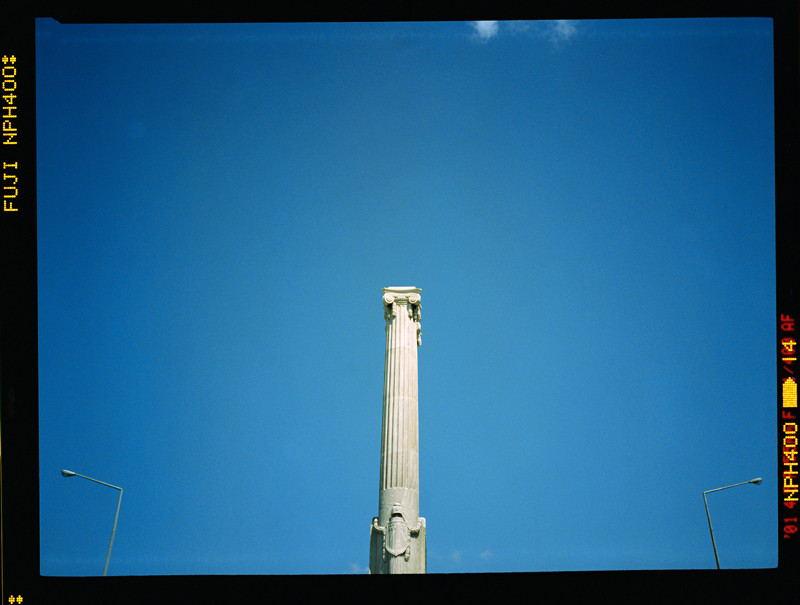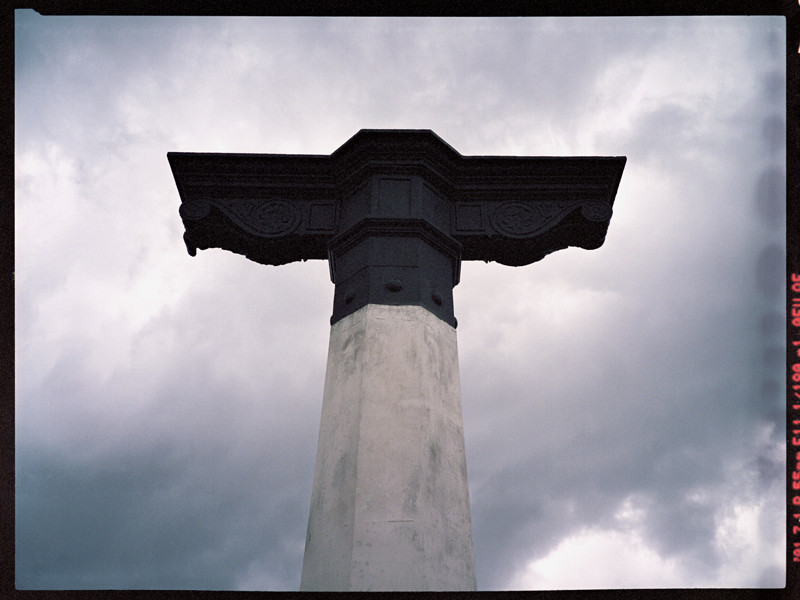[Spring 2002]
Piña photographed sites where monuments were taken down during the 1959 Revolution. He presents these sites as discrete markings: an indexical history that is erased.
by Petra Watson
The idea of mapping the historical landscape depends on the construction of perspective, a view from the present, around which the panoramas of history are made to resolve.1
Unstable identities emerge in Manuel Piña’s mapping of place and historical past: memory assumes the form of the landscape itself. On Monuments (2000) is a series of photographs that comments on the rewriting of history, ideologies, and the obliteration of the past.2 At the end of Spanish colonization and during the American domination of Cuba’s commerce and political relations, the construction of monuments established visual ideological foundations for a new economy and society. In On Monuments, Piña photographed sites where monuments were constructed on Havana’s central boulevard, Avenida de los Presidentes (Avenue of the Presidents), and nearby streets. The monuments (or, in some cases, only proposed commemorative sites) of the series title were statues depicting pre-revolutionary presidents and generals, known for their corruption and pro-American allegiances. These monuments were destroyed during the 1959 Cuban Revolution, leaving only obscure markings, footprints in cement, and empty plinths. “Portraits of sites,” Piña calls these deserted spaces: portraits that present two faces coexisting in an uneasy tension.
Piña presents these now empty sites as a series of discrete markings: an indexical history that is erased. The large colour photographs do not set out to directly reproduce the physical environment of the city, but the landscape that they encounters appear through traces, vestiges, and historical dialogues. In this contingent view, the city lives through remembering. The past is a mobilizing force that engenders a rethinking of the built environment and its social framework, as history is imbedded within the city as an active form, not as disengaged source material.
The eleven photographs that make up the series On Monuments portray a landscape of absence as well as of presence. They do not identify a fixed perception of the city; the images construct narratives that reveal broad cultural, social, and political meanings. The urban environment is read as map and metaphor for both revolutionary ideals and Revolution, and these are seen to take place as much in the shattering of identities as in the construction of them. Piña’s photographs refer to Cuban history through an allegorical reading of the public space of the city and its social-political milieu. The layering of geography and time suggests the process whereby a historical reality is produced, maintained, and altered. As Piña states, “The history of Cuba is the manipulation of evidence and documents.” History, in general, is never disinterested, but operates within terms of authority and legitimation “to produce a narrative sanctioned by power.”3 These portraits of sites hold in balance both the raw materials of history and an urban landscape of displaced memory.
Henri Lefebvre describes “monumental space” as operating within two “primary processes”: first, displacement, “implying metonymy, the shift from part to whole,” and second, “condensation, involving substitution, metaphor and similarity.”4 Monumental space in On Monuments is a metaphorical and quasi-metaphysical underpinning of a society through which the attributes of ideologies are constituted as a dialogue between the people and city landscape. And central to this inquiry into monumentality and power is an exploration of the mechanisms at work behind revolutionary ideals and utopian movements. Revolutionary governance takes place in public, in the piazza and on the street. Havana’s empty public squares, a product of revolution and urbanization, provide only a fragment of vision. Tracing this landscape through cracked cement and empty plinths also comments on the isolated freeze-frame of the photograph itself.
Piña’s approach is to question both ideologically mediated space and the formal concerns of photography played out within an interface between the camera and social/political space. This inquiry began earlier, in a 1996 series of black-and-white photographs (De)constructions and Utopias (Tribute to Eduardo Muñoz). In these small photographs, form is suggestive of content, and each photograph works to “construct” the built environment and “deconstruct” supporting ideologies that result in fragmentation and rupture of social space.
This photographic installation refers to microbrigadas, a building project of the 1980s that attempted to address the housing shortage in Cuba. The government embarked on housing projects in which labour was to be exchanged for an apartment. These projects were halted in 1989, and many remain unfinished. Piña does not directly document social housing, but uses negatives from photographs by Eduardo Muñoz (who documented this building project in the 1980s) to construct history and memory as a utopian moment. He takes these documentary images and, through displacement and substitution, shifts their meaning from fact to fiction, from reality to illusion. Piña writes,
The intent of the installation is to convert the room into a utopian space (or its remains). The way the pieces are mounted, their shape and make-up, the variation in tempo, are an attempt to integrate the pieces into the site. . . I thought it appropriate to use images from the microbrigadas, a popular movement for the construction of housing, because of the close connection between the terms utopia and construction.5
Piña’s appropriated images suggest a “documentary style” that returns the image to the everyday while preserving formal placement as inseparable from the articulation of social/political space and representation.
For Piña, the photographs in (De)constructions and Utopias (Tribute to Eduardo Muñoz) position representation as part of a larger historical framework of inquiry. This approach asks, on the one hand, how the camera might be used for social commentary, and, on the other, how the photographic documentation of social space is focused on the image as index or trace, an event rather than an object, which is far closer to the utopian moment itself. In this way photographs are not interpreted as copying nature; rather, in the transferring of three-dimensional phenomena to a flat plane, the photograph breaks its ties with the real and constructs anew. This is consistent with the idea that utopias are ”sites with no real place”, although they have “a general relation or direct or inverted analogy with the real space of Society. They present society itself in a perfected form, or else society turned upside down, but in any case these utopias are fundamentally unreal spaces.”6
In a series of black-and-white photographs from 1992–94, entitled Water Wastelands, Piña photographed Havana’s sea promenade along the Malecon jetty that marks the city shoreline. Images of a broad expanse of water both suggest the history of Cuba as a space of multiple passage – Columbus, Spain, the United States, the Revolution – and provide for a cancellation of this panoramic view. Not set up for a pleasurable stroll along the sea-front promenade, the ocean is a forlorn-looking space within a utopian impulse suggesting both a vast expanse and a dead end. As defined by Piña, this “trauma of space” refers to the actual immigration of Cubans as much as an unrealized utopian notion of “encountering eternity.”7
This is the paradox of Piña’s disconcerting views. The panoramic space of the photographs speaks to these contradictions as both “displacement” and “condensation.”8 Representation thus remains problematic and the viewer of any of these recent photographic series is left not with a descriptive plenitude, but a sense of absence, the emptiness that remains at the centre of ideology and utopia.
1 F. Driver, “Geography’s Empire: Histories of Geographical Knowledge,” Environment and Planning D: Society and Social Space, 10 (1992): 36.
2 Piña exhibited these photographs with Arni Haraldsson in the exhibition Displacement and Encounter: Projects and Utopias, curated by Petra Watson, at the Canadian Museum of Contemporary Photography, an affiliate of the National Gallery of Canada, Ottawa, from January 24 to April 7, 2002. This exhibition is travelling to Presentation House Gallery, North Vancouver, in the fall of 2002. Both artists look at historical conditions that reflect on the present. In a series of images titled The Centre of Paris (1999), Haraldsson photographed the coordinates of Le Corbusier’s unbuilt project the Plan Voisin. Views from the street and from high-vantage points map the city centre that would have been demolished if this project had gone ahead. In part, this feature article extracts from the text panels written for this exhibition.
3 Artist Statement, 2001–02.
4 Henri Lefebvre, The Production of Space, trans. Donald Nicholson-Smith (Oxford, UK, and Cambridge, MA: Blackwell Publishers), p. 225.
5 Quoted in Utopian Territories: New Art From Cuba (Vancouver: Morris and Helen Belkin Art Gallery, University of British Columbia; Contemporary Art Gallery; and Havana: Ludwig Foundation of Cuba, 1997), p. 104.
6 Michel Foucault, “Of Other Spaces,” Diacritics 16 (1986): 24.
7 Manuel Piña quoted in Utopian Territories: New Art from Cuba, p. 21.
8 Refer to Lefebvre’s quote above.
Petra Watson is a Vancouver-based curator and public art consultant. She has worked independently and in a number of galleries. She has published extensively and is presently researching panoramic photography from the daguerreotype to the Circuit camera, and its absence from the history of photography. She has studied at the Nova Scotia College of Art and Design, the University of British Columbia, and Simon Fraser University, where she has a MA in communication (cultural studies), and is a doctoral candidate in interdisciplinary studies.

